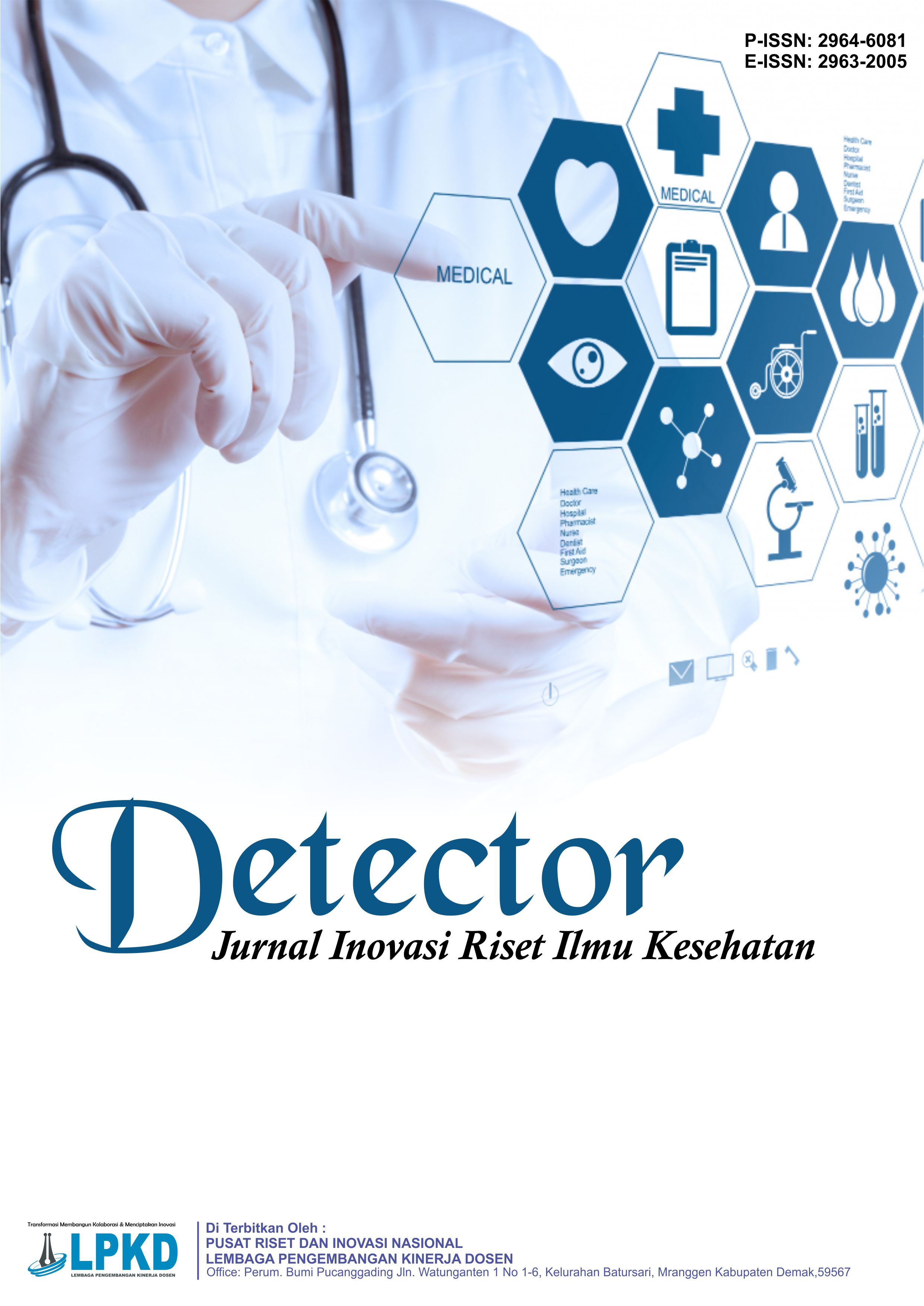Mental Health of Healthcare Professionals in the Conflict Zone of Syam : an Analysis of Burnout and Secondary Trauma
DOI:
https://doi.org/10.55606/detector.v3i2.5005Keywords:
Burnout, Conflict Zone, Healthcare Workers, Resilience, Secondary TraumaAbstract
This study investigates the profound impact of the protracted humanitarian crisis in the conflict zone of Syam on the mental health of healthcare professionals, employing a systematic meta-analytical approach across 47 independent studies (N = 12,487) published between 2011 and 2023. The findings reveal an alarmingly high prevalence of burnout, reaching 78.3% (95% CI [75.2–81.4]), with emotional exhaustion recorded as the most dominant dimension (M = 3.89; SD = 0.76). Additionally, secondary trauma was identified in 65.7% of all respondents (95% CI [62.4–69.0]), with the primary symptoms manifesting as post-traumatic stress disorder (PTSD) at 44.2% and depression at 39.8%. Meta-regression analysis demonstrated that the duration of exposure to conflict (β = 0.42; p < 0.001) and the intensity of workload (β = 0.38; p < 0.001) served as significant predictors of burnout. Meanwhile, the lack of psychosocial support (OR = 2.34; 95% CI [1.89–2.79]) and critical resource scarcity (OR = 1.98; 95% CI [1.65–2.31]) were strongly correlated with the emergence of secondary trauma among healthcare professionals. Furthermore, diverging from the more individualistic frameworks employed in the studies of Bdaiwi et al. (2020) and Bou-Karroum et al. (2020), this research explores the intricate entanglement of organizational and situational determinants that concurrently shape the mental health landscape of medical personnel operating in the Syam conflict zone. Moreover, the study's original contribution lies in identifying resilience adaptation patterns observed in 34.2% of participants, revealing that endurance capacity was cultivated through collective coping strategies and close peer support. According to the researchers, this study offers a new lens for designing community-based psychological interventions that are both sustainable and contextually grounded for healthcare providers affected by the protracted armed conflict in Syam.
Downloads
References
Abbara, A., Rayes, D., Tappis, H., Hamze, M., Wais, R., Alahmad, H., ... & Haar, R. (2023). "The psychological wounds are more difficult than physical injuries:" A qualitative analysis of the impacts of attacks on health on the personal and professional lives of health workers in the Syrian conflict. Conflict and Health, 17(1), 48.
Abdulah, D. M., & Mohammed, A. A. (2020). The consequences of the COVID-19 pandemic on perceived stress in clinical practice: experience of doctors in Iraqi Kurdistan. Rom J Intern Med, 58(4), 219–227.
Abu-El-Noor, N. I., Aljeesh, Y. I., Radwan, A. S., Abu-El-Noor, M. K., Qddura, I. A. I., Khadoura, K. J., & Alnawajha, S. K. (2016). Post-traumatic stress disorder among health care providers following the Israeli attacks against Gaza Strip in 2014: A call for immediate policy actions. Archives of Psychiatric Nursing, 30(2), 185–191.
Afzal, M. H., & Jafar, A. J. N. (2019). A scoping review of the wider and long-term impacts of attacks on healthcare in conflict zones. Medicine, Conflict and Survival, 35(1), 43-64.
Akhtar, A., Bawaneh, A., Awwad, M., Al-Hayek, H., Sijbrandij, M., Cuijpers, P., & Bryant, R. A. (2021). A longitudinal study of mental health before and during the COVID-19 pandemic in Syrian refugees. European Journal of Psychotraumatology, 12(1), 1991651.
Al Houri, H. N., Alhouri, A., Arrouk, D. M. N., Al Houri, A. N., Jomaa, S., Sharabi, A., ... & Latifeh, Y. (2023). Stress, depression, anxiety, and quality of life among the healthcare workers during COVID-19 pandemic in Syria: a multi-center study. Annals of General Psychiatry, 22(1), 41.
AlAteeq, D. A., Aljhani, S., Althiyabi, I., & Majzoub, S. (2020). Mental health among healthcare providers during coronavirus disease (COVID-19) outbreak in Saudi Arabia. Journal of Infection and Public Health, 13(10), 1432–1437.
Alhaffar, B. A., Abbas, G., & Alhaffar, A. A. (2019). The prevalence of burnout syndrome among resident physicians in Syria. Journal of Occupational Medicine and Toxicology, 14, 1–8.
Alhaffar, M. B. A., & Janos, S. (2021). Public health consequences after ten years of the Syrian crisis: a literature review. Globalization and Health, 17(1), 111.
Almohsen, C., Soqia, J., & Mohsen, S. (2024). Burnout levels and correlates among healthcare providers in Syria following the 2023 Turkish–Syrian earthquakes: A cross‐sectional study. Health Science Reports, 7(5), e2080.
Alrubaiee, G. G., Al-Qalah, T. A. H., & Al-Aawar, M. S. A. (2020). Knowledge, attitudes, anxiety, and preventive behaviours towards COVID-19 among health care providers in Yemen: an online cross-sectional survey. BMC Public Health, 20, 1-11.
Aysazci-Cakar, F., Schroder, T., & Hunt, N. (2022). A systematic review of prevalence and correlates of post-traumatic stress disorder, depression and anxiety in displaced Syrian population. Journal of Affective Disorders Reports, 10, 100397.
Bdaiwi, Y., Rayes, D., Sabouni, A., Murad, L., Fouad, F., Zakaria, W., ... & Abbara, A. (2020). Challenges of providing healthcare worker education and training in protracted conflict: a focus on non-government controlled areas in north west Syria. Conflict and Health, 14, 1–13.
Bercier, M. L., & Maynard, B. R. (2015). Interventions for secondary traumatic stress with mental health workers: A systematic review. Research on Social Work Practice, 25(1), 81-89.
Bou-Karroum, L., El-Harakeh, A., Kassamany, I., Ismail, H., El Arnaout, N., Charide, R., ... & Akl, E. A. (2020). Health care workers in conflict and post-conflict settings: systematic mapping of the evidence. PloS One, 15(5), e0233757.
Bou-Orm, I. R., Moussallem, M., Karam, J., deLara, M., Varma, V., Diaconu, K., ... & Witter, S. (2023). Provision of mental health and psychosocial support services to health workers and community members in conflict-affected Northwest Syria: a mixed-methods study. Conflict and Health, 17(1), 46.
Brooks, M. A., Dasgupta, A., Taşğın, N. Ş., Meinhart, M., Tekin, U., Yükseker, D., ... & El-Bassel, N. (2022). Secondary traumatic stress, depression, and anxiety symptoms among service providers working with Syrian refugees in Istanbul, Turkey. Journal of Immigrant and Minority Health, 24(6), 1421-1430.
Cameron, L., McCauley, M., van den Broek, N., & McCauley, H. (2024). The occurrence of and factors associated with mental ill-health amongst humanitarian aid workers: A systematic review and meta-analysis. PLoS One, 19(5), e0292107.
Carpiniello, B. (2023). The mental health costs of armed conflicts—a review of systematic reviews conducted on refugees, asylum-seekers and people living in war zones. International Journal of Environmental Research and Public Health, 20(4), 2840.
Charlson, F., van Ommeren, M., Flaxman, A., Cornett, J., Whiteford, H., & Saxena, S. (2019). New WHO prevalence estimates of mental disorders in conflict settings: a systematic review and meta-analysis. The Lancet, 394(10194), 240–248.
Chemali, Z., Ezzeddine, F. L., Gelaye, B., Dossett, M. L., Salameh, J., Bizri, M., ... & Fricchione, G. (2019). Burnout among healthcare providers in the complex environment of the Middle East: a systematic review. BMC Public Health, 19, 1-21.
Duffy, E., Avalos, G., & Dowling, M. (2015). Secondary traumatic stress among emergency nurses: a cross-sectional study. International Emergency Nursing, 23(2), 53–58.
Edwards, J. R. (2008). 4 person-environment fit in organizations: An assessment of theoretical progress. Academy of Management Annals, 2(1), 167–230.
Elbarazi, I., Loney, T., Yousef, S., & Elias, A. (2017). Prevalence of and factors associated with burnout among health care professionals in Arab countries: a systematic review. BMC Health Services Research, 17, 1–10.
Elhadi, M., Msherghi, A., Elgzairi, M., Alhashimi, A., Bouhuwaish, A., Biala, M., ... & Albakoush, A. (2020). Psychological status of healthcare workers during the civil war and COVID-19 pandemic: A cross-sectional study. Journal of Psychosomatic Research, 137, 110221.
Fardousi, N., Douedari, Y., & Howard, N. (2019). Healthcare under siege: a qualitative study of health-worker responses to targeting and besiegement in Syria. BMJ Open, 9(9), e029651.
Hamdan, M., & Hamra, A. A. A. (2017). Burnout among workers in emergency Departments in Palestinian hospitals: prevalence and associated factors. BMC Health Services Research, 17, 1-7.
Hamid, A., Scior, K., & de C Williams, A. C. (2020). Qualitative accounts from Syrian mental health professionals: shared realities in the context of conflict and forced displacement. BMJ Open, 10(5), e034291.
Hamza, M. K., & Hicks, M. H. R. (2021). Implementation of mental health services in conflict and post-conflict zones: Lessons from Syria. Avicenna Journal of Medicine, 11(01), 8-14.
Hendrickx, M., Woodward, A., Fuhr, D. C., Sondorp, E., & Roberts, B. (2020). The burden of mental disorders and access to mental health and psychosocial support services in Syria and among Syrian refugees in neighboring countries: a systematic review. Journal of Public Health, 42(3), e299-e310.
Hobfoll, S. E. (2011). Conservation of resources theory: Its implication for stress, health, and resilience. The Oxford Handbook of Stress, Health, and Coping, 127, 147.
Kamali, M., Munyuzangabo, M., Siddiqui, F. J., Gaffey, M. F., Meteke, S., Als, D., ... & Bhutta, Z. A. (2020). Delivering mental health and psychosocial support interventions to women and children in conflict settings: a systematic review. BMJ Global Health, 5(3), e002014.
Kunzler, A. M., Stoffers-Winterling, J., Stoll, M., Mancini, A. L., Lehmann, S., Blessin, M., ... & Lieb, K. (2021). Mental health and psychosocial support strategies in highly contagious emerging disease outbreaks of substantial public concern: A systematic scoping review. PloS One, 16(2), e0244748.
Lazieh, S. M., Tarnas, M. C., Wagner, K., Alkhatib, I., Polinori, C., Netfagi, M., ... & Burnham, G. (2025). Healthcare workers' perceptions of postoperative care and implementation challenges in conflict-affected northwest Syria: a mixed-methods analysis. BMJ Public Health, 3(1).
Lopes Cardozo, B., Gotway Crawford, C., Eriksson, C., Zhu, J., Sabin, M., Ager, A., ... & Simon, W. (2012). Psychological distress, depression, anxiety, and burnout among international humanitarian aid workers: a longitudinal study.
Maalouf, F. T., Alamiri, B., Atweh, S., Becker, A. E., Cheour, M., Darwish, H., ... & Akl, E. A. (2019). Mental health research in the Arab region: challenges and call for action. The Lancet Psychiatry, 6(11), 961–966.
Oweidat, I., Omari, A., ALBashtawy, M., Alrahbeni, T., Al-Mugheed, K., & Alsheikh, A. D. I. (2024). Factors affecting the quality of working life among nurses caring for Syrian refugee camps in Jordan. Human Resources for Health, 22(1), 1.
Pfortmueller, C. A., Schwetlick, M., Mueller, T., Lehmann, B., & Exadaktylos, A. K. (2016). Adult asylum seekers from the Middle East, including Syria in Central Europe: What are their health care problems? PloS One, 11(2), e0148196.
Quosh, C., Eloul, L., & Ajlani, R. (2013). Mental health of refugees and displaced persons in Syria and surrounding countries: a systematic review. Intervention Journal of Mental Health and Psychosocial Support in Conflict Affected Areas, 11(3), 276-294.
Rahmat, Z. S., Aamar, H., Siddiqui, J. A., Mirha, H. T., Hassan, M., Essar, M. Y., ... & Hashim, H. T. (2022). Mental health impacts of humanitarian crisis on HCWs in Syria amidst COVID-19. Medicine, Conflict and Survival, 38(1), 23–30.
Sá, F. H. D. L., Waikamp, V., Freitas, L. H. M., & Baeza, F. L. C. (2022). Mental health outcomes in Syrian refugees: A systematic review. International Journal of Social Psychiatry, 68(5), 933-953.
Sagaltici, E., Cetinkaya, M., Nielsen, S. Y., Sahin, S. K., Gulen, B., & Altindag, A. (2022). Identified predictors and levels of burnout among staff workers in a refugee camp of first immigrant group: A cross-sectional study. Medicine, 11(1), 135-41.
Shoib, S., Swed, S., Alibrahim, H., Ezzdean, W., Almoshantaf, M. B., Siddiqui, M. F., & Chandradasa, M. (2022). Mental health services in Syria: Challenges and opportunities. Asian Journal of Psychiatry, 76, 103246–103246.
Spivey, S. E. (2016). Conflict and care: mixed methods research of Israeli healthcare providers and Syrian patients and their caregivers (Doctoral dissertation, University of Georgia).
UNHCR. (2022). Syria situation - Global Focus. Retrieved from https://reporting.unhcr.org/syria-situation-global-report-2022Global Focus+6
World Bank & World Health Organization. (2021). HeRAMS: Health Resources & Services Availability Monitoring System – Syria. Retrieved from https://joomla.emro.who.int/-images/stories/syria/04-HeRAMS-Annual-Public-Hospitals-Report-2021.pdf
World Health Organization. (2021). HeRAMS Annual Public Hospitals Report 2021. Retrieved from https://joomla.emro.who.int/images/stories/syria/04-HeRAMS-Annual-Public-Hospitals-Report-2021.pdf
Downloads
Published
How to Cite
Issue
Section
License
Copyright (c) 2025 Detector: Jurnal Inovasi Riset Ilmu Kesehatan

This work is licensed under a Creative Commons Attribution-ShareAlike 4.0 International License.








